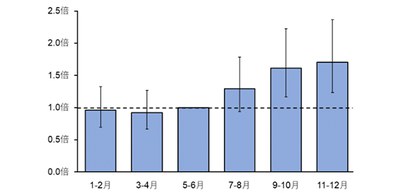
Glycemic control significantly deteriorates after 2018 North Osaka Earthquake despite limited damage of lifelines
A group of researchers from the Graduate School of Medicine of Osaka University clarified that glycemic control of diabetes patients deteriorated for several months after the 2018 North Osaka Earthquake with a magnitude of 6.1 on the Richter Magnitude scale and a Japanese seismic intensity of 6−.
The Osaka earthquake hit northern Osaka Prefecture on June 18, 2018. Damage to lifelines and transportation networks was limited and completely recovered within several days. Although Osaka University Hospital restricted outpatient services on the day of the earthquake, the damage was limited and full clinical services were resumed on the next day.
Diabetes is a disease that occurs when your blood sugar (glucose) is too high. If left untreated, a risk of developing various complications, such as loss of vision and being on dialysis, increases. Glycemic control is fundamental to diabetes management and many clinical guidelines from professional organizations recommend tight glycemic control (HbA1c <6.5 or 7%).
It was known that glycemic control in diabetic patients deteriorated after the Great Hanshin Earthquake in 1995 due to enormous damagesto lifelines, transportation networks, and medical services. However, it was unknown whether glycemic control in diabetic patients would deteriorate for months after prompt recovery from a natural disaster with limited damage to lifelines and transportation networks.
In order to find out whether glycemic control would deteriorate over months after the 2018 North Osaka Earthquake, the researchers retrospectively analyzed HbA1c levels in diabetic outpatients attending the Department of Metabolic Medicine of Osaka University Hospital.
Hemoglobin, a protein in red cells, carries oxygen from the lungs to all parts of the body. When glucose builds up in your blood, it binds to the hemoglobin in your red blood cells, becoming glycosylated hemoglobin (also referred to as hemoglobin A1c, or HbA1c).
Since your blood glucose levels increase, more of your hemoglobin will be combined with glucose. As average red blood cell life is about 120 days, the glycosylated hemoglobin level reflects the average blood glucose level during the previous 2 to 3 months. The A1C test measures your average blood sugar level over that period. An A1C below 5.7% is normal and 6.5% or higher indicates you have diabetes.
In this study, the researchers examined whether HbA1c levels increased after the earthquake. Compared to the same period in 2017, mean HbA1c levels in 2018 were significantly higher 3–6 months after the earthquake. More patients had risk of HbA1c ≥ 7.0%, which is the target value to prevent complications for several months or longer.
The researchers also investigated whether the post-earthquake HbA1c elevation was more prevalent in areas with a higher seismic intensity using the mixed effects model. The proportion of HbA1c deterioration after the earthquake was found to be higher in areas with a higher seismic intensity. The post-earthquake HbA1c deterioration was correlated with the seismic intensity in 2018.
Recently, earthquake-resistant construction of houses and buildings has enabled a quick recovery of the disaster-stricken areas and restoration of normal levels of social activity even after a large earthquake. Glycemic control in diabetic patients significantly deteriorate over months after a disaster even when damage of lifelines and transportation networks is limited. To provide better treatment for diabetic patients, medical staff need to consider these impacts by earthquakes as well.
Figure 1
The article, “Glycemic control of people with diabetes over months after the 2018 North Osaka Earthquake,” has been published in the Diabetology International on 8th Nov at DOI:
https://link.springer.com/article/10.1007/s13340-020-00438-6.
Related Links
Department of Metabolic Medicine of Osaka University Hospital (link in Japanese)
